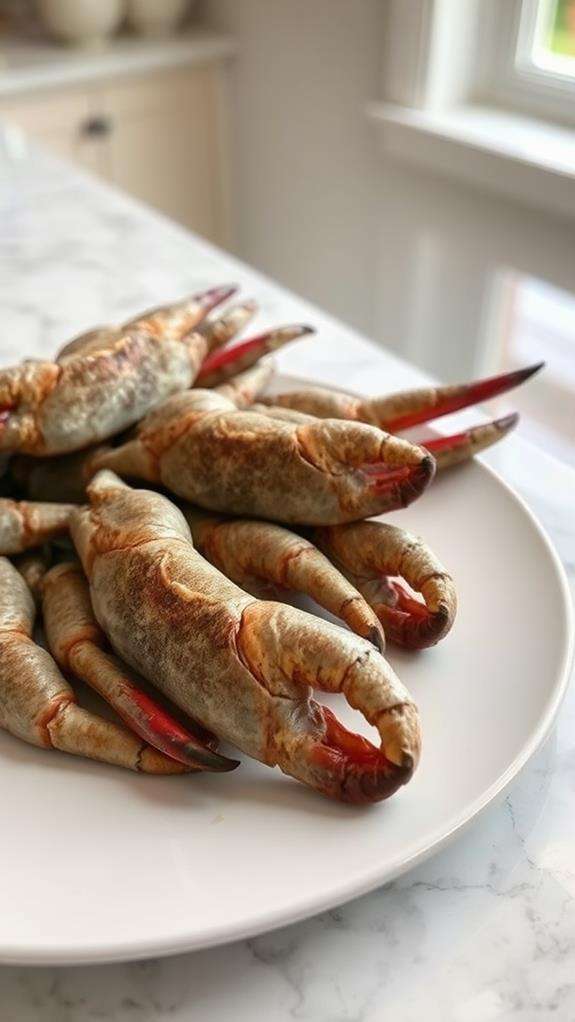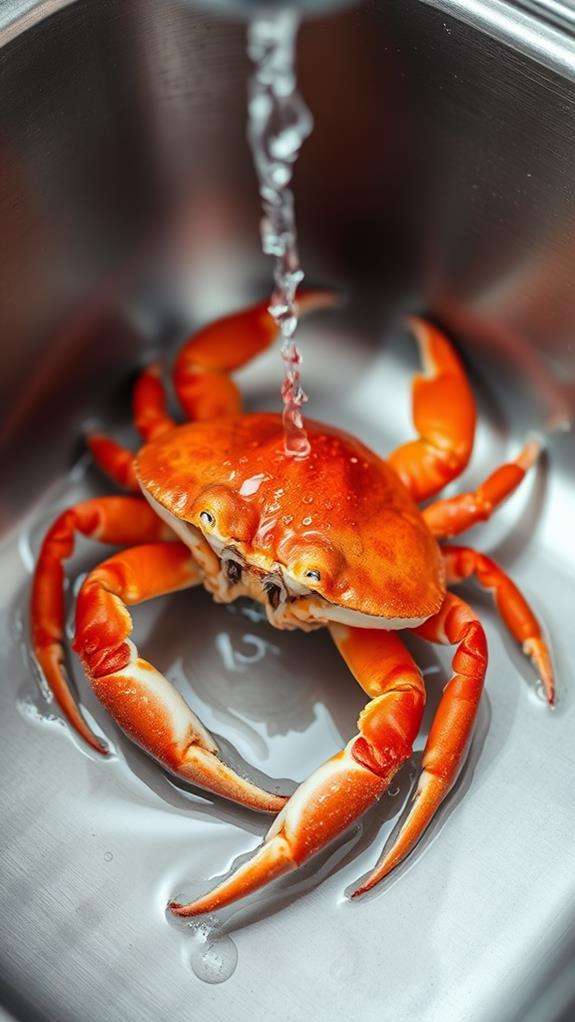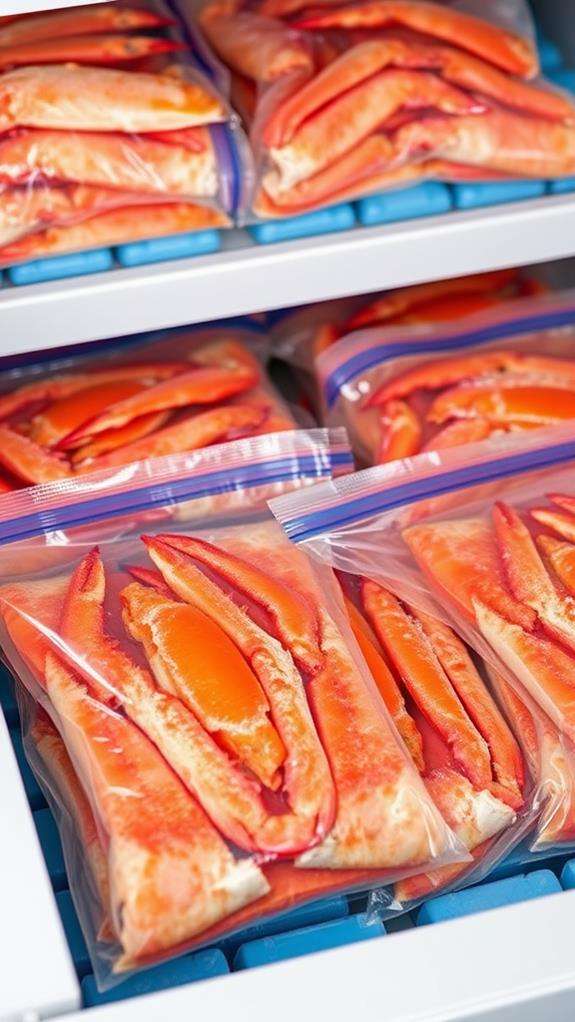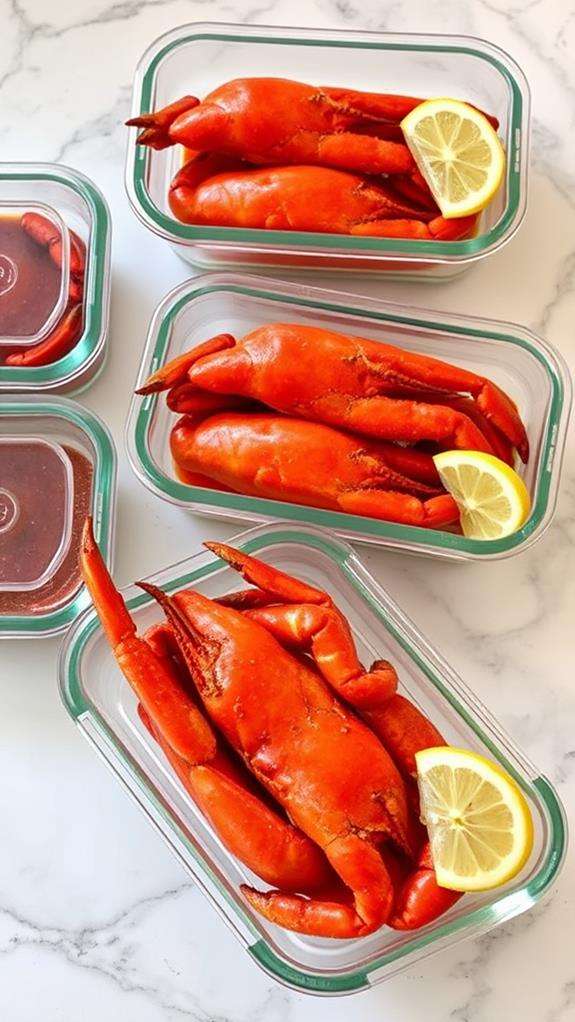How to Store Leftover Crab Legs
To store leftover crab legs properly, pack them in airtight containers or heavy-duty Ziploc bags within two hours of cooking, removing as much air as possible. You'll want to rinse them under cold water first, then thoroughly dry them with paper towels to prevent freezer burn. For short-term storage, place them in the coldest part of your refrigerator and consume within 3-5 days. For longer preservation up to six months, vacuum-seal the legs and store them in your freezer at 0°F or below. Remember to label containers with dates and check for any signs of spoilage like unusual odors or sliminess. Understanding proper storage techniques guarantees you'll get the most from your seafood investment.
This post may contain affiliate links. If you make a purchase through these links, I may earn a commission at no additional cost to you. Additionally, portions of this post may be generated using artificial intelligence (AI) technology. While we strive for accuracy, please be aware that AI-generated content may not always be perfect and should be fact-checked when necessary.
The Spatula Scoops
- Store crab legs in airtight containers or Ziploc bags within 2 hours of cooking, removing as much air as possible.
- Keep refrigerated crab legs at coldest part of fridge and consume within 3-5 days for best quality.
- For long-term storage, vacuum-seal and freeze at 0°F, where they'll last up to six months.
- Clean legs thoroughly under cold water and dry completely with paper towels before storage.
- Label containers with storage date and check for signs of spoilage like sliminess or unpleasant odors before eating.
The Basics of Crab Storage

The proper storage of leftover crab legs doesn't have to be complicated, but it requires prompt attention after your meal. You'll want to pack your leftovers in either Ziploc bags or airtight containers as soon as possible, guaranteeing that you've removed as much air as possible to maintain ideal freshness. Unlike some seafood storage methods, you don't need to worry about submerging the crab legs in water, which makes the storage process much more straightforward.
When you're storing your crab legs in the refrigerator, make sure you're using containers that seal completely to prevent any air from getting in. You'll need to consume these refrigerated leftovers within a few days to guarantee the best quality and food safety. If you're planning to keep your crab legs for a longer period, consider vacuum-sealing them before placing them in the freezer, where they can last for several months without losing their quality. Remember, the key to successful storage lies in the speed with which you refrigerate your leftovers after cooking, as this greatly reduces the risk of bacterial growth and helps maintain the crab's delicate flavor.
Signs of Spoiled Crab

Your nose is your first line of defense against spoiled crab, as any unusual or unpleasant odors signal immediate spoilage requiring disposal. When checking your leftover crab legs, you'll want to watch for rapid temperature fluctuations, which can quickly turn safe seafood into a breeding ground for harmful bacteria. If your crab legs have spent any significant time above 40°F (4°C), particularly overnight at room temperature, you shouldn't risk eating them, even if they look perfectly fine.
Common Spoilage Warning Signs
Spotting spoiled crab legs quickly can prevent a nasty bout of food poisoning. You'll need to rely on your senses to identify warning signs that indicate your seafood has gone bad. One of the most reliable indicators is smell – if you detect any unusual or unpleasant odors coming from your crab legs, it's time to discard them immediately.
Watch for visual cues that suggest spoilage, including any discoloration or changes in texture. If your crab meat appears slimy or has developed an unusual film, you shouldn't risk consuming it. Temperature abuse is another critical factor to take into account – if you've accidentally left your crab legs at room temperature overnight, they're no longer safe to eat, regardless of their appearance. You'll want to pay special attention to how your leftover crab has been stored, as rapid temperature fluctuations can accelerate spoilage.
When cleaning your crab, make sure you're thorough, as improperly cleaned seafood can harbor dangerous bacteria. If you're unsure about the safety of your leftover crab legs, it's always better to err on the side of caution and dispose of them rather than risk foodborne illness.
Storage Temperature Dangers
Temperature control stands at the heart of food safety when storing crab legs. You'll need to monitor your leftovers carefully, as even brief exposure to room temperature can trigger rapid bacterial growth. When you leave crab legs out for more than two hours, you're fundamentally creating an ideal environment for harmful microorganisms to multiply.
You shouldn't risk consuming crab legs that have experienced significant temperature fluctuations, particularly if they've gone through multiple cycles of thawing and refreezing. These temperature changes can compromise the meat's cellular structure and lead to unsafe conditions. If you've accidentally left your crab legs out overnight, don't take chances – they should be discarded immediately. Watch for clear warning signs of temperature-related spoilage, including unusual odors or the development of a slimy texture on the meat's surface. Before storing your leftover crab legs, you'll want to verify they're properly cleaned, as any remaining debris can accelerate spoilage even at safe temperatures. Remember that proper temperature control isn't just about refrigeration – it's about maintaining consistent cold temperatures from the moment you finish your meal until you're ready to consume the leftovers.
Proper Cleaning Before Storage

Proper cleaning is essential before storing leftover crab legs to prevent bacterial growth and maintain their quality. You'll need to start by thoroughly examining your crab legs and removing any visible debris, shell fragments, or suspicious portions that might show signs of spoilage. If you notice any sections with an off-putting odor or questionable appearance, it's vital to discard them immediately.
Begin the cleaning process by placing your crab legs under cold running water, making sure to rinse every surface thoroughly. Pay special attention to the joints and crevices where shell fragments and residue tend to accumulate. While you're rinsing, gently run your fingers along the shells to detect any remaining particles that need removal. Once you've completed the rinse, you'll need to dry the crab legs meticulously using paper towels. This step is particularly important because excess moisture can lead to freezer burn and compromise the quality of your seafood during storage. After drying, you're ready to place your clean crab legs in airtight containers or heavy-duty freezer bags, ensuring you've removed as much air as possible before sealing.
Refrigeration Tips and Guidelines

Once your crab legs are clean and dry, storing them correctly in the refrigerator will preserve their flavor and safety. You'll want to place your leftover crab legs in airtight containers or high-quality Ziploc bags, making certain to squeeze out as much air as possible before sealing them completely. This step is essential for maintaining freshness and preventing any unwanted odors from permeating other foods in your refrigerator.
When storing your crab legs, you don't need to add any water to the container, as keeping them dry will actually help maintain their quality better. Be certain you're placing them in the coldest part of your refrigerator, typically near the back, where the temperature remains most consistent. You'll need to consume your refrigerated crab legs within 3 to 5 days to guarantee both safety and ideal taste. If you're planning to keep them longer, consider vacuum-sealing and freezing them instead, which can extend their shelf life greatly. Remember to label your storage containers with the date you're putting them away, so you can easily track how long they've been stored and avoid any food safety issues.
Freezing Methods for Extended Life

When you're ready to freeze your leftover crab legs, vacuum sealing offers the most effective protection against freezer burn and can extend shelf life up to six months. For the best results, you'll want to select thick, freezer-grade storage containers or heavy-duty freezer bags that can withstand temperatures between 0°F and -10°F (-18°C to -23°C). If you don't have a vacuum sealer, you can still achieve good results by pressing out as much air as possible from freezer bags, wrapping the crab legs tightly in plastic wrap first, and then double-bagging them for extra protection.
Vacuum-Seal for Best Results
The most effective way to preserve leftover crab legs for extended periods is through vacuum-sealing. This method creates an airtight barrier that prevents freezer burn and maintains the delicate flavor of your seafood for up to six months or longer. When you're ready to store your crab legs, verify your vacuum sealer is clean and functioning properly to achieve the tightest possible seal.
If you don't have access to a vacuum sealer, you'll find that using heavy-duty freezer bags can work as a temporary solution. While not as effective as vacuum-sealing, you can still achieve decent results by pressing out as much air as possible from the freezer bags before sealing them. Remember to label your packages clearly with the storage date, which will help you track freshness and confirm you're consuming the crab legs within their ideal timeframe. You'll want to position the crab legs in a single layer within the vacuum-seal bag or freezer bag to maintain even freezing and prevent any sharp edges from puncturing the packaging. This careful arrangement will help guarantee the best possible preservation of your seafood investment.
Proper Container Selection Tips
Selecting proper storage containers stands as your first line of defense against freezer burn and spoilage when preserving crab legs. You'll want to focus on airtight options that can create a reliable barrier between your seafood and the harsh freezer environment.
For the best results, you'll need to choose between two primary storage methods. First, consider using high-quality airtight containers with secure, snap-on lids that won't pop open during storage. These containers should be appropriately sized to minimize excess air space, which can contribute to freezer burn. Your second option is heavy-duty freezer bags, preferably those with double-seal technology for enhanced protection. If you're using bags, you'll want to squeeze out as much air as possible before sealing.
For ideal long-term storage, vacuum sealing remains your premium choice. This method removes virtually all air from the package, greatly extending shelf life and maintaining the crab meat's quality. Whichever container type you select, don't forget to clearly label it with the storage date using a permanent marker or adhesive label – this simple step will help you track freshness and make sure you're consuming your crab legs within a safe timeframe.
Quick-Freeze Temperature Guide
Proper freezing temperatures play an essential role in preserving your leftover crab legs' flavor and texture. To achieve ideal results, you'll need to set your freezer temperature to 0°F (-18°C) or lower, which helps prevent freezer burn and maintains the meat's quality. Before freezing, make sure you've let your crab legs cool to room temperature, as this prevents unwanted moisture from forming during the freezing process.
When you're ready to freeze your crab legs, place them directly into a pre-chilled freezer to avoid temperature fluctuations that could compromise their quality. If you're using vacuum-sealed bags, remove as much air as possible to prevent ice crystals from forming inside the packaging. For those using regular containers or Ziploc bags, press out excess air before sealing them tightly. Don't forget to label your containers with the freezing date, as you'll want to consume the crab legs within six months for the best taste and texture. This systematic approach to freezing temperatures and storage methods guarantees your leftover crab legs will maintain their delicious flavor and remain safe to eat when you're ready to enjoy them again.
Best Storage Containers

Choosing the right storage container for leftover crab legs can make the difference between preserving their delicate flavor and letting them go to waste. You'll find that vacuum-sealed bags offer the most effective solution, as they completely eliminate air contact and greatly extend your crab legs' shelf life in both the refrigerator and freezer.
If you don't have a vacuum sealer, Ziploc bags are your next best option. When using these, you'll want to press out as much air as possible before sealing to minimize the risk of freezer burn. For shorter storage periods, airtight containers work well, especially if you're planning to enjoy your leftover crab legs within a few days. While aluminum foil can serve as a temporary solution for refrigerator storage, it's not ideal for long-term preservation. Whatever container you choose, make sure it's completely dry inside, as excess moisture can compromise the quality of your crab meat. Don't store your crab legs in water-filled containers, as this method can lead to bacterial growth and affect the meat's texture, ultimately reducing its shelf life.
Frequently Asked Questions
Can You Keep Leftover Crab Legs?
Yes, you can definitely keep leftover crab legs. You'll want to store them in an airtight container or Ziploc bag in your refrigerator, where they'll stay fresh for 3-4 days. If you're planning to keep them longer, you can freeze them for up to 6 months. For the best results, wrap them tightly and remove as much air as possible from the container. Don't store them in water, as this can affect their texture and taste.
What Is the Best Way to Reheat Crab Legs?
Want to enjoy those crab legs as if they're fresh from the steamer? Your best option is to steam them for 5-7 minutes, which preserves their moisture and enhances flavor. If you don't have a steamer, wrap them in foil and heat in a 350°F oven for 15 minutes. You can also microwave them in a covered dish with water, heating in 1-minute intervals. Just avoid high temperatures, as they'll dry out your crab legs.
How Do You Store Cooked Crabs Overnight?
To store cooked crabs overnight, you'll need to act quickly. Place your leftover crab legs in an airtight container or Ziploc bag within two hours of cooking. Don't submerge them in water, as this can ruin their texture. Make sure they're sealed well to prevent air exposure, then put them in your refrigerator. They'll stay fresh for 3-4 days, but you'll want to eat them soon for the best flavor.
How to Save Leftover King Crab?
To save your leftover king crab, let it cool completely first, then wrap it tightly in plastic wrap or place it in an airtight container. You'll want to store it in your refrigerator for up to 3-5 days. For longer storage, vacuum seal the crab legs and freeze them, where they'll last for several months. Don't store them in water, as this can affect quality. Remember to label your container with the storage date.





